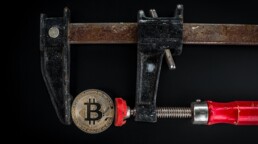Various types of Bitcoin wallets
Today we are going into details about the different types of wallets for Bitcoin.
As I have already told you, having a wallet where you can put your bitcoins is essential, it is one of the absolutely necessary steps to invest.
However, there are different types of wallets, all created accordingly to the needs of the owners.
The first diversification is between custodial and non-custodial wallet.
A custodial wallet is for example a wallet on an exchange, where you can use the wallet but you don't have control over it since you don't have the private keys.
Non-custodial wallets, on the other hand, are wallets that you can access via private keys and are in your full control.
This category is divided into hardware wallets and software wallets.
Let's start with the first type, namely the hardware wallets.
A hardware wallet is a physical wallet, practically a USB key that we can hold in our hands.
The most famous models are the Nano S or X and the Trezor.
These wallets are perfect for securing large amounts of coins and are fairly easy to use.
Another point in their favor is the vast support, in fact they allow you to have different types of coins saved inside them.
The safety of use is one of the fundamental points of this type of wallet, safety that you pay dearly given the purchase cost, based on the wallet model chosen, which is particularly high.
These wallets then need to use special software to work, such as Ledger Live for the Nano.
Let's move on to software wallets, which are a type of wallet that we can have on a device such as a phone or laptop.
One of the most popular wallets is electrum wallet, which is free and open source. It is a wallet dedicated only to bitcoins and we must say that it does not have a really nice user interface. But it works, is appreciated by users and is safe thanks to the fact that it is open source.
It also works with some hardware wallets.
Now let's talk about the wallet of hardcore Bitcoin professionist, let's talk about bitcoin core wallet.
Now let's understand, this wallet is specific only for people who know what they are doing since it downloads the entire bitcoin blockchain on their pc, and we are talking about gigabytes of memory.
This wallet is the ultimate in privacy and is obviously only for bitcoin and only for pc.
You will have complete autonomy and full possession of the tools of the bitcoin blockchain, so it is not for those who are just starting out. Even the interface doesn't help.
Now that you know what the various types of wallets for your bitcoins are, you just have to decide what to use in complete safety.
Learn more about safety here.
Bitcoin halving in May 2020
The bitcoin halving is an event that occurs every about 4 years and halves the remuneration of closing a block of the Bitcoin blockchain. It is one of the main features of bitcoin monetary management.
In order to better understand what we are talking about, however, we must review 3 fundamental points which are:
Bitcoin blockchain
Mining
And the total supply of money
Talking about the BlockChain, it is a live record of all bitcoin transactions. The blocks are made up of the transactions within them, and the blocks are linked together in an indissoluble way.
The block is created when a defined number of transactions are made and the block can contain a maximum number of that transactions. Reaching this number, the block is closed and added to the block previously mined and linked to it.
When a Bitcoin transaction occurs, the data is communicated to the network of computers that validate the transaction, add the transaction to the bitcoin ledger and transfer the ledger change to all computers on the network. Since there is a maximum of data that can be saved in a block, a block is closed approximately every 10 minutes
Mining is how transactions are verified within the coin network. The verification and creation of the blocks is created by the miners. Each group of transactions has a cryptographic hash of the previously published block and this connects all to the previously created blocks creating the blockchain. To accept a new block on the network, miners are required to follow a proof of work system that involves the creation of a new cryptographic hash to add to the new block. To be added to the register requires the creation of a new single hash which will go through a validation process and then will be passed to the next block and so on. To create a new hash, miners compete with each other using the computing power of their computers to be the first to have the 64 digit hexadecimal number or hash that is at the same target difficulty level as the network.
The thing to understand is that the miners are remunerated at the closing of each new block with new bitcoins created by the system and by the transaction fees, which are already circulating btc. The rewards are created to incentivize miners to participate in the bitcoin blockchain.
Learn more about Mining here..
The amount of money.
Bitcoin was created as digital gold. Satoshi deliberately created bitcoin with characteristics similar to the physical gold. The principle of mining bitcoin is similar to gold mining, which is long and difficult. Another feature is the maximum amount of bitcoins that can be created which has been programmed to be 21 million. This number was created to copy the inflationary stability of gold. In this case, the term inflation is used for the growth of the amount of money that is not covered by gold in a gold standard.
In the modern way of understanding the term inflation, bitcoin is deflationary because his purchasing power grows over time. Compare it to the gold extraction profile where in the future the cost of extraction will be increasingly higher and more difficult and therefore the previous quantity of gold extracted will increase in value because no more can be produced at low prices.
In the old concept of inflation, bitcoin is inflationary because, not being covered by gold, the quantity of bitcoin grows as the creation of blocks by miners increases. There are now 18 million in circulation. At the current rate, the last bitcoin will be created in 2140
Let's go into the halving detail
The halving referred to the bitcoin blockchain is the reduction of the closing reward of a block for miners to half the previous number. The current reward is 6.25 bitcoins per block.
The halving takes place every 210,000 closed blocks and therefore more or less every 4 years since a block is closed every 10 minutes. Initially, the block reward was 50 bitcoins, which dropped to 25 in 2012 and then 12.5 in 2016
But why does halving happen? Satoshi planned halving to lower bitcoin monetary inflation. In addition, the technological advancement factor of mining machines is also considered and for this there is an increase in the difficulty of creating new blocks to lower the validation speed.
With 12.5 bitcoins per block and 10 minutes of build per block, around 1,800 bitcoins are created daily. After May 2020 these dropped to 900 bitcoins per day.
Now returning to the previous parallel with gold.
It is considered one of the best stores of value due to the fixed presence and its scarcity which is imposed by nature.
The bitcoin algorithm is created to make it scarce. So as the demand for bitcoin grows, the value will grow. There have been major rises in btc prices months after each halving, but this is a trading strategy that you may or may not consider.
Bitcoin as it is created in its algorithm, is made to be scarce and therefore grow in value as long as people like you and me believe in its intrinsic philosophy.
Bitcoin Lightning Network
Lightning Network is one of the solutions for one of the problems of bitcoin.
Lightning Network is a system created on top of the Bitcoin blockchain, with specific rules, to have fast and fee-free transactions.
We all know Bitcoin is cool but it's not perfect. Bitcoin has limitations such as the speed and cost of transactions.
In a particularly dense period of transactions, not high enough fees and blocks every 10 minutes, can make your purchase or move from one wallet to another really slow and expensive.
Lightining network should solve all these problems. The concept of this system has been developed since 2015 and we have to imagine that it works as if it were a layer cake.
On layer 1 we have Bitcoin with the blockchain while on layer 2 we have the lightning network system.
This feature is created specifically for micropayments, so that all micro transactions are not written on the bitcoin blockchain. At least not immediately.
The payment channels are created so if I want to send funds to a friend of mine or to a shopkeeper we can open a payment channel between the two of us, with our payments not involving the main blockchain. the transaction will take place at the speed with which the two wallets are able to communicate with each other.
When the transactions between the two wallets are complete, a main transaction will be created and written to the main Blockchain.
Now, if we thought of a series of regular, small-scale transactions, such as coffee at the bar every morning, each transaction sent to the main bitcoin blockchain would cost us more in lost time and fees than the transaction itself. Does it make sense to spend 10 dollars of coffee and 20 on commissions?
NO
Now let's imagine opening a payment channel for my entire CY Mood team with my favorite bartender. Upon opening the payment channel, both parties deposit a certain amount of money to guarantee the total transactions. If I know my team drinks 100 coffees a week I will deposit an equal or greater amount.
On the main Bitcoin BlockChain there will be only 2 transactions, namely the first transaction to open the payment channel and deposit the coin and a second to "close" or complete the payment
Now if we go back to our second layer, thousands millions of transactions can take place within the payment channel without these being written to the main blockchain. My team will be able to drink thousands of coffees and every time they buy, they will write an X BTC transaction to the barista
Weekly, monthly or every time my barista friend wants to cash out the coffee bitcoins, he will decide to write the transaction on the main BlockChain.
The system works best for small repeating transactions, we can think of our baker or the barber. There is obviously a system against scams, for those who want to close the payment channel in advance and not pay anything. In this case, the total of the initial deposit would be sent to the scammer. This greatly discourages scams.
Another interesting ability of the Lightning network is the ability to make payments to people with whom we do not have an open channel, but using other people's channels.
Step 3 - Wallets
In this article we're going to talk about cryptocurrencies wallets. We will face all types of wallet to discover this super important tool of the crypto world.
The wallet is the tool to use to interact with a blockchain.
Wallets can be divided into software, hardware and paper wallets. These can be considered Hot or cold wallets.
Let's start by saying that most wallets are of the software type because they are more practical to use than the others. However, hardware wallets are the safest option, while paper wallets are now an outdated option. But let's see how it works.
Any wallet allows you to interact with the Blockchain, creating the information necessary to create transactions, receive and send the crypto currencies compatible with the wallet. The wallet does not "physically" contain the coins, but rather the public and private keys to operate on the blockchain and the public address that is created based on public and private keys.
The address is a specific point on the blockchain from which to receive and send coins. Coins never leave the Blockchain but simply change their address.
For this reason, you now understand why the private keys of the wallet should never be revealed. In fact, the private key is the only way to access your coins. In case of a possible loss of your mobile phone, you will be able to access your wallet again with the private key.
Now let's face the difference between cold and hot Wallet. In fact, wallets can operate in a different way.
A hot wallet is any wallet connected to the Internet. When you create any exchange account and transfer coins from your wallet to the address assigned on that exchange, you are transferring funds to the exchange's hot wallet, so that your funds are immediately available for trading.
Cold wallets have no Internet connection, so they are safer from cyber attacks and better set up to store coins over the long term.
Now let's see the different types of wallets and which is the best compromise of use.
Let's start with the Software wallets, there are of all types and characteristics, and specific by currency. Obviously, the vast majority are connected to the internet, so they are hot wallets. Software wallets are divided into web, desktop and mobile wallets.
Web Wallet
With a web wallet, you can access the blockchain with a browser interface without having to download or install anything. The most classic example is the wallet of any exchange.
You create a new wallet and set a password to access it. In the case of an exchange wallet there is no private key, you are entrusting your funds to another person, in this case the exchange
Desktop Wallet
The desktop wallet is software that you download and use on your computer.
A desktop wallets give you full control over your keys and funds.
When the desktop wallet is created, in most cases a file called "wallet.dat" is created and stored locally on your computer. This file contains the private key information used to access your addresses, so it must be protected. Remember that if you delete it or lose your computer and don't have a backup, you lose all the funds on the wallet.
A good solution is to export the private key or seed phrase corresponding to your newly created wallet, so that it can also be used on other devices at a later time. Since the wallet is on your PC, it must be protected from malware or viruses.
Mobile Wallets
Mobile wallets are a very similar alternative to desktop wallets but designed for smartphones. They are the most practical wallets for everyday use as they allow you to send and receive crypto by scanning QR codes. The problem of viruses and malware is also present here, so you need to protect your device. In addition, given the daily use of the smartphone, it is necessary to have all the back up of the wallet for any recovery following theft or loss.
Hardware Wallets
Hardware wallets are physical electronic devices, not connected to the network except for their use. They generate random numbers to create public and private keys that are stored within them. Their intrinsic greater safety, however, is balanced by a less simple and quick use.
Hardware wallets are used in case you want to keep large amounts of crypto for a long time. The access PIN must always be set and the recovery phrase saved as in web wallets.
Paper Wallet
the paper wallet is a piece of paper on which a public address and its private key are physically printed via QR codes. Code scanning allows you to perform cryptocurrency transactions. This kind of wallet can be considered a good alternative to long-term crypto storage, given its resistance to online attacks.
The biggest problem lies in the fact in order to use the paper wallet, the total amount of crypto currencies in it must be moved.
If we have a 15 Bitcoin wallet and we only have to move 3 of them, we will first have to make an intermediate step to another address where you will send all 15 bitcoins, and then from there send the 3 you need. The remaining 12 will then have to be put back safely on another paper wallet
Remember that your paper wallet will be empty after its first outgoing transaction. So don't hope you can use it again later.
As we have already repeated, it is essential for each wallet to have the back up and the seed phrase to recover their wallet in case of problems.
Learn more about safety about your Coin here.






